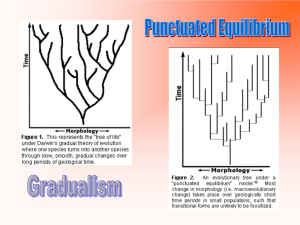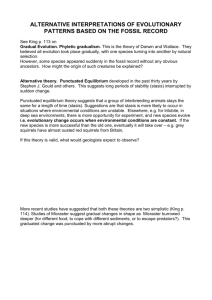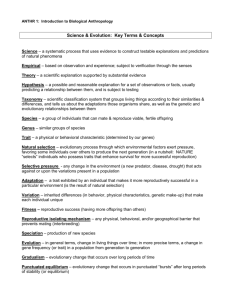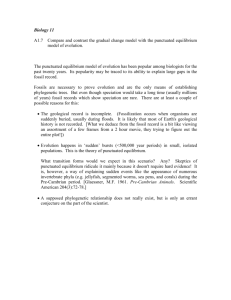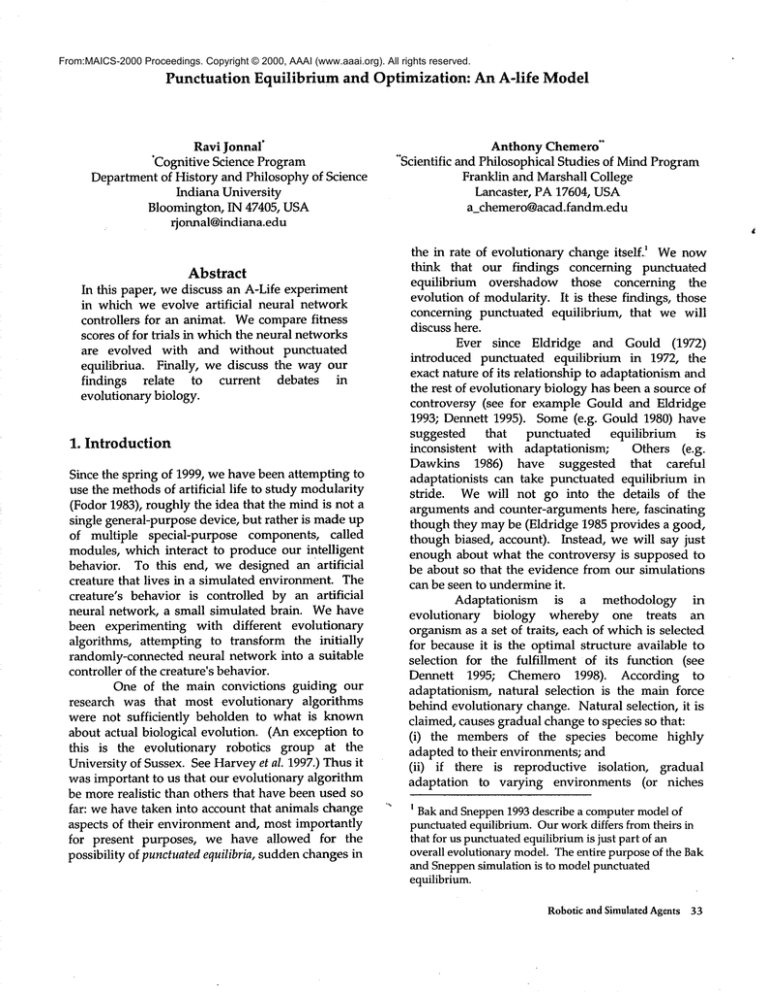
From:MAICS-2000 Proceedings. Copyright © 2000, AAAI (www.aaai.org). All rights reserved.
Punctuation
Equilibrium
and Optimization:
Ravi Jonnaf
"Cognitive Science Program
Department of History and Philosophy of Science
Indiana University
Bloomington, IN 47405, USA
rjonnal@indiana.edu
Abstract
In this paper, we discuss an A-Life experiment
in which we evolve artificial
neural network
controllers for an animat. We compare fitness
scores of for trials in which the neural networks
are evolved with and without punctuated
equilibriua.
Finally, we discuss the way our
findings
relate
to
current
debates
in
evolutionary biology.
1. Introduction
Since the spring of 1999, we have been attempting to
use the methods of artificial life to study modularity
(Fodor 1983), roughly the idea that the mind is not
single general-purpose device, but rather is made up
of multiple special-purpose
components, called
modules, which interact to produce our intelligent
behavior. To this end, we designed an artificial
creature that lives in a simulated environment. The
creature’s behavior is controlled by an artificial
neural network, a small simulated brain. We have
been experimenting with different
evolutionary
algorithms, attempting to transform the initially
randomly-connected neural network into a suitable
controller of the creature’s behavior.
One of the main convictions
guiding our
research was that most evolutionary
algorithms
were not sufficiently
beholden to what is known
about actual biological evolution. (An exception to
this is the evolutionary
robotics group at the
University of Sussex. See Harvey et al. 1997.) Thus it
was important to us that our evolutionary algorithm
be more realistic than others that have been used so
far: we have taken into account that animals change
aspects of their environment and, most importantly
for present purposes, we have allowed for the
possibility of punctuated equilibria, sudden changes in
"Scientific
An A-life
Model
Anthony Chemero"
and Philosophical Studies of Mind Program
Franklin and Marshall College
Lancaster, PA 17604, USA
a_chemero@acad.fandm.edu
the in rate of evolutionary change itself.!
Wenow
think that our findings concerning punctuated
equilibrium
overshadow those concerning
the
evolution of modularity. It is these findings, those
concerning punctuated equilibrium,
that we will
discuss here.
Ever since Eldridge
and Gould (1972)
introduced punctuated equilibrium
in 1972, the
exact nature of its relationship to adaptationism and
the rest of evolutionary biology has been a source of
controversy (see for example Gould and Eldridge
1993; Dennett 1995). Some (e.g. Gould 1980) have
suggested
that
punctuated
equilibrium
is
inconsistent
with adaptationism;
Others (e.g.
Dawkins 1986)
have suggested
that careful
adaptationists can take punctuated equilibrium in
stride.
We will not go into the details of the
arguments and counter-arguments here, fascinating
though they may be (Eldridge 1985 provides a good,
though biased, account). Instead, we will say just
enough about what the controversy is supposed to
be about so that the evidence from our simulations
can be seen to undermine it.
Adaptationism
is a methodology
in
evolutionary
biology whereby one treats
an
organism as a set of traits, each of which is selected
for because it is the optimal structure available to
selection for the fulfillment of its function (see
Dennett 1995; Chemero 1998). According
to
adaptationism, natural selection is the main force
behind evolutionary change. Natural selection, it is
claimed, causes gradual change to species so that:
(i) the members of the species become highly
adapted to their environments; and
(ii) if there is reproductive isolation,
gradual
adaptation
to varying environments (or niches
l Bak and Sneppen1993 describe a computer modelof
punctuated equilibrium. Our work differs from theirs in
that for us punctuatedequilibriumis just part of an
overall evolutionary model. The entire purpose of the Bak
and Sneppensimulation is to model punctuated
equilibrium.
RoboticandSimulatedAgents33
within the same environment) can lead to speciation.
According to the proponents of punctuated
equilibrium (Eldridge and Gould 1972; Gould and
Eldridge 1993), for the majority of time species are in
evolutionary stasis, with little or no change occuring
and hence little or no increase in adaptation to their
environments.
Occasionally,
often due to some
environmental
catastrophe,
there
will be
punctuations, periods of rapid evolutionary change
during which speciations
occur.
Evolution,
according to punctuationist,
is not gradual
adaptation to the environment, but proceeds in
occasional fits and starts,
without necessarily
increasing fit between animal and environment. As
Michael Ruse (1992) has put it, it is hard to imagine
how the sort of discontinuous
and very rapid
change that occurs in punctuations could "stay in
adaptive focus". Thus, punctuated equilibrium
seems to amount to a denial of both the claims of
adaptationists
outlined
above.
On (i)
punctuationists
claim that, except when speciation
occurs, species are in stasis and do not become
increasingly adapted to their environments; on (ii),
punctuationists claim that gradual natural selection
alone is insufficient for speciation, which requires a
punctuation event. This apparent conflict led Gould
to say (infamously)
that "the new synthesis
effectively dead" in 1980.
In this paper, we describe experiments in
artificial life in which a neural networkis artificially
evolved to control a virtual creature.
With the
evolutionary algorithm employed in the artificial
evolution, it is possible to simulate punctuated
equilibirum.
The aim of the experiments
we
describe is to compare the fitness in animats whose
evolution includes punctuations with the fitness of
animats whose evolution does not. We will argue
that the results of these experiments call the
apparent
opposition
between
punctuated
equilibrium and adaptationism into question.
2.
Methods
2.1 The animat and environment
The model used here was designed
for two
purposes: to investigate the effects of punctuated
equilibrium on artificial evolution and to investigate
the conditions under which modularity evolves (or
fails to evolve) in an artificial system. Only the first
is discussed here. The model consists of a simulated
organism (Bukowski, hereafter) and its behavior in
34 MAICS-2000
simple,
but changing,
environment.
The
environment consists of a two-dimensional grid of n
x m squares, each of which may be occupied by an
obstacle, a resource, Bukowski, or a waste product.
The grid is bounded on all four sides by obstacles.
At the start of each epoch (an epoch consists
of 200 time steps),
Bukowski is given a random
position and direction in the grid, and a fixed
number of resources and obstacles
are randomly
distributed throughout the grid. Over the course of
the epoch,
Bukowski
moves around
the
environment, consuming resources, colliding with
obstacles, leaving a messy trail of waste products,
and occasionally moving through one of the latter.
The frequency of each of the previous events is
recorded. Whenever a resource is used, another is
placed at a random position in the environment.
The waste products remain in the environment for
an average of 10 time steps, after which they are
removed, regardless
of whether Bukowski moves
over them or not.
In the interest of computational tractability,
we decided to simulate some aspects in very general
and sketchy ways. Bukowski consumes an object
whenever it is in the same position as the object. It
may consume resources
or waste products.
Similarly with obstacles, Bukowski collides with an
obstacle whenever it attempts to move into the
obstacle’s position; it of course cannot consume an
obstacle.
2.2 The controller
Bukowski is controlled
by a three-layer
feedforward artificial
neural network (ANN). It has
seven input nodes, which correspond to each of the
organisms seven simulated sensors: three obstacle
sensors,
two resource
sensors,
and two waste
sensors. The ANNhas twenty nodes in the second,
hidden, layer, none of which are connected laterally.
It has two output nodes, which control
the
organism’s movement. The input and hidden layers
are fully connected (i.e. each input node is connected
to each hidden node), as are the hidden and output
layers.
There are a total of 29 nodes and 180
connections. The nodes have activation values in
the range [0, 1] and the connections have weights in
the range [-1, 1], where positive values signify
excitation and negative ones inhibition.
At the start of each time step, the simulator
uses the position of Bukowski, the configuration of
the environment, and certain information about the
sensors
to determine
which objects
in the
environment affect which sensors. It then computes
an activation value for the sensor based upon how
many objects
are affecting
it and from what
distances,
and then adds a sensor/environmental
noise term which changes the computed activation
by a random number in the range [-0.1, 0.1].
The activation
of each hidden and output
node is determined by the activations of input and
hidden nodes, respectively,
and input to hidden
weights and hidden to output weights, respectively,
by applying the logistic function to sums of relevant
products:
1
aj -n
-y" a~w~
l+e ,--o
where aj is the activation of node j, wij is the
connection weight between nodes i and j, and n is
the number of nodes in the relevant layer.
The activations of the two output nodes are
used to compute Bukowski’s new position
and
orientation, using a rough simulation of two stepper
motors. The sensors are updated once more, and so
on.
2.3 The evolutionary algorithm
Bukowski’s genome consists
of an array of 180
floating point numbers in the range [-1, 1], which are
the connection weights of the ANN.
Initially,
a population
of animats is
generated, each with a randomly generated genome.
Each animat is placed in different
randomly
generated environments, for one epoch each, and
the numbers of resource-consumptions,
wasteconsumptions,
collisions,
and movements are
recorded,
and the animat’s overall fitness is
computed with a fitness function (see below). When
all animats in the population have been similarly
’tested’,
the genomes of the 10% with the highest
overall fitnesses
are used to generate a new
population of animats, each one being responsible
for a fixed numberof offspring.
The offspring are created by copying the
parental genome and allowing for mutations. Two
sorts of mutations are simulated: small mutations,
which alter a single value randomly by a number in
the range [-0.1, 0.1]~ and large mutations which
randomly reassign the weight a value in the range [1.0, 1.0]. To allow for the possibility of entirely
severed connections, any new weight between -.08
and .08 is reassigned a value of 0.
The overall rate of mutations Ix determines
both the rate of large and small mutations. After
trying several ways of computing the rates, we
found that using Ix - Ix2 for the rate of small
mutations and Ix 2 for the rate of large mutations
produced interesting
results.
With some informal
experimentation~ we determined that setting !1 to
0.04 resulted in larger overall fitness gains than ~t =
0.01, IX = 0.02, or Ix = 0.06, and so chose Ix = 0.04 to be
our base mutation rate.
So, the next generation is populated with
mutated parental genotypes, and same steps are
performed on it.
2.4 The fitness function
Hereit is:
c
F = 500L-50m
t
t
where r, w, c, In, and t represent the numbers of
resource-consumptions,
waste-consumptions,
collisions, movements, and time steps, respectively,
over the course of an individual animat’s lifespan.
The motivation for using movements in the first
term rather than time steps is the fact that in real
biological systems, movementsare costly.
2.5 Punctuated mutation rates
In some trials, instead of keeping Ix constant for the
entire trial, we introduced a probability p that ~t
increases by some factor m over the course of a trial,
such that for an individual generation, there is
probability p that the mutation rate is set to m~t.
We ran punctuated
trials
with many
different
values of both p and m, but will only
discuss trials where p=.02 and m=2, such that the
maximummutation rate is 2Ix.
2.6 The experiment
We ran the trials
in pairs,
pairing
one
nonpunctuated trial with one punctuated trial.
In
each trial, a population of 100 animats was evolved
for 200 generations. Each individual animat is put
into five different randomly generated environments
for one epoch each. For the nonpunctuated trials,
the mutation rate Ix was set to .04, and for the
punctuated trials
the base mutation rate was the
same, while the punctuation frequency p was set to
.02 and the punctuation magnitude m was set to 2.
Robotic and Simulated Agents 35
Trial
Initial
Fitness
Final
Fitness
Fitness
Change
1-control
1-punctuated
7.64
6.32
49.55
109.58
41.91
103.26
2-control
2-punctuated
6.47
7.74
142.81
161.87
136.34
154.13
3-control
3-punctuated
4.79
6.43
46.68
52.18
41.89
45.75
4-control
4-punctuated
4.67
10.41
40.14
53.26
35.47
42.85
5-control
5-punctuated
3.28
5.42
45.53
43.07
42.25
37.65
3. Results
t
In all cases, the artificial
evolution improved the
Bukowski’s fitness.
This was evident in two ways:
first,
in every trial the fitness scores improved
during evolution;
second, it was there was vast
improvement in the creature’s
overall behavior.
Initially,
with randomly generated networks, the
animats were unable to avoid obstacles and waste or
find food. Indeed, some were unable to move at all.
After evolution, however, the creatures do seek out
food sources and rarely bump into obstacles. This
result is unsurprising.
A surprising
result is that there was a
notable difference
between the degree to which
fitness
improved in the punctuated
and nonpunctuated trials. In all but one case, the trials that
included occasional punctuations had final fitness
scores that were better than the scores of the trials
that had no punctuations. Also, in all but one case
the change in fitness during evolution was greater in
the punctuated cases. In one pair of trials (trials 1control and 1-punctuated), in fact, the creature from
the punctuated trial had a final fitness score that was
more than twice as high as the control, despite the
fact that its initial fitness score was slightly lower.
(See Table 1.)
Table I
The mean final fitness and mean change in
fitness were considerably higher in the punctuated
trials. This is summarizedin Table 2.
Figure1: Trial 1 Contro
120
100
8O
E 60
LL
40
2O
0
0
36 MAIGS-2000
2O
4O
6O
80
100
120
Generation
140
160
180
200
Trial Type
Mean
Initial
Fitness
Mean
Final
Fitness
Mean
Fitness
Change
control
5.37
64.94
59.57
punctuated
7.26
83.99
76.73
Table 2
It is worthwhile to look more closely at the
way the fitness changes over time in the actual trials.
Because the differences
between the control and
punctuated trials are most striking in the first pair,
we will focus our attention there. Trial pairs 2-4
differ from pair 1 in degree only. Trial pair 5, in
which the final fitness and overall fitness gains are
greater in the non-punctuated trial, will be discussed
below.
In trial 1-control (see Figure 1), there
initially
a rather steep gain in fitness.
From
generation 0, in which the brain has been randomly
generated, to generation 30, the fitness increases
34.70 points, from 7.64 to 42.34. Then, after a slight
decrease (4.54 points) caused by an unfortunate
mutation, the fitness changes are less dramatic.
Figure2: Trial 1 Punctuatec
From generation 30 to generation 199, the
overall fitness ranges from a low of 34.84 to a high of
55.26, reaching a final value 49.55. As is evident
from the rolling ayerage depicted in figure 1, there is
an overall upward trend for these generations, but
the slope is rather modest. This is exactly what an
adaptationist
such as Dennett or Dawkins would
expect in non-artificial evolution: as time passes, the
evolutionary algorithm yields a slow, but steady,
increase in adaptive fit between creature and
environment.
Compare this to trial 1-punctuated, in which
in 2% of the generations
have doubled mutation
rates. In this trial, as in 1-control, there is an initially
steep gain in fitness (see Figure 2). But unlike in the
control trial, this overall trend continues, despite
occasional large decreases in fitness.
A notable
example of this is the punctuation that occurs at
generation 166, where fitness suddenly drops 44.18
points from 96.84 to 52.66, a decrease of more than
45% in one generation. Sudden drastic changes such
as this one are like the speciation
events that
punctuationists
such as Eldridge and Gould (1972)
discuss. And just as they suggest, there are two
different sorts of change that occur: normal, slow
increases
in fitness
and sudden, more drastic
changes like that which occurs at generation 166.
But notice that after the punctuation occurs, the
fitness gains are dramatic, and the creature that
results is significantly morefit. In this case, the final
fitness was 109.58.
120
100
80
40
2O
0
2O
4O
6O
80
100
120
140
160
180
200
Generation
RoboticandSimulated
Agents 37
Adding punctuations
to the trials
had
similar, though less dramatic, effects in trial pairs 24. In trial 5, however, there was a sudden fitness
decrease of more than 15%at the 188t" generation of
the punctuated group (from 55.40 to 46.51). The
remaining 12 generations were not sufficient
to
make up for the losses (See figure 3). Because
this, the final fitness was lower in the punctuated
trial than in the control trial in this pair. But note
that the maximumfitness in the punctuated trial
(55.40), which was the result, in part, of earlier
punctuations, was higher than the maximumfitness
of the non-punctuatedtrial (51.34) in this pair.
4. Discussion
local maxima, allowing to get to more global
maxima. Whether or not this is the reason that
punctuations
tend to improve optimization,
our
research clearly indicates that they do.
This apparently purely practical result has
implications
for theoretical
questions
in
evolutionary biology.
In particular,
it raises doubts about the
supposed opposition
between adaptationism
and
punctuated equilibrium. If, as our results suggest, it
is possible for punctuations in evolving systems to
produce net increases in fitness,
adaptationists
might begin to see punctuated equilibrium not as an
obstacle to their methodology, but rather as a way in
which the adaptations they seek might occur.
Figure3: Trial 5 Punctuatec
60
50
4O
30
,,~
2O
10
0
20
40
60
80
100
120
140
160
180
200
Generation
Our results suggest that in artificially
evolving
systems, punctuating periods of relatively neutral
evolution with brief increases in mutation rate can
result in better overall fitness gains. That is,
punctuated
equilibrium
can be used as an
optimizing tool in evolutionary algorithms research
and application. Although this is just speculation,
we think that punctuations helped improve overall
fitness by "bumping" the evolving system out of
38 MAICS-2000
It is often thought
that punctuated
equilibrium implies that not all (perhaps not many)
traits
of organisms are adaptations
to their
environments.
Just as gradual adaptive change
increases the degree of fit between the animal and its
environment, so too, in the long run, do changes
caused by punctuation. In fact, in the long run,
punctuation along with gradual change may result
in better fit than gradual change alone. Our results
indicate
that far from being a hindrance
to
adaptation, punctuations can in fact be one of its
motors. If our findings in this limited artificial
context
have a real,
biological
correlate,
adaptationists
would no longer need to make
apologies or excuses for the apparent existence of
punctuations.
These findings are surprising, and we ought
to admit that we find them somewhat troubling.
Our initial
motivation for modeling punctuated
equilibrium
was what we take to be the overly
adaptationist
leanings of much of the research in
artificial
life and evolutionary roboticsJ And now
our findings might be interpreted to mean that the
adaptationists
were right all along, and for more
reasons, it turns out, than even they realized.
One way to question these implications
would be to suggest that our model of punctuated
equilibrium is inappropriate in one way or another.
It might be argued, for instance, that what causes
punctuations
in natural biological
systems is
environmental
upheaval,
and not sudden and
temporary changes in the mutation rate. Maybe.
But the overall effect is very similar. In both
environment
driven and mutation rate driven
punctuated equilibrium, there are brief periods of
poor fit between animal and environment, followed
by longer periods of gradual adaptation and also
neutral evolution. Were the poor fit in our model
caused by simulated environmental catastrophe,
would the results have been different?
We have
doubts that they would, but a more confident
answer will require
more research.
(We are
currently conducting these experiments.)
It might alternatively
be argued that what
causes punctuations
is the founder effect,
as
suggested by (Gould and Eldridge 1993). When
small subpopulation is geographically isolated from
the original population, the subpopulation does not
represent the allele frequencies present in the
original population, and there are new or different
selective
pressures on the subpopulation,
rapid
evolutionary change may occur. It is true that the
punctuations
in our model are not caused by
isolation of subpopulations. However, there is an
interesting
similarity
between brief surges in
mutation and what occurs in the founder effect. In
both cases, there have been random changes in the
genetic makeup of the population. In the founder
effect this is due to the small sample size; in our
model it is due to the increase in the mutation rate.
This potential objection, like the one before
it, can only be answered definitively
by more
simulation.
In the meantime we might wonder
whether
the apparent
conflict
between
adaptationism
and punctuated
equilibrium
is
merely apparent.
We might also wonder whether
the protracted and often bitter argument over this
matter has been just so muchhot air.
Acknowledgements
Jonnal would like to thank the Indiana University
Cognitive Science Program for funding this research.
Chemero would like to thank the Franklin
and
Marshall College Committee on Grants.
Works Cited
Chemero, A. (1998).
Teleosemantics
and the
critiques of adaptationism. Evolution and
Cognition, 4: 136-144..
Bak, P. and Sneppen, K. (1993).
Punctuated
equilibrium and critically in a simple model
of evolution. Phys.Rev. Letters, 71:4083-408
Dawkins, R. (1986). The Blind
York: Norton.
Dennett,
Watchmaker. New
D. (1995) Darwin’s Dangerous Idea. New
York: Simon and Schuster.
Eldridge, N. (1985). Timelines. NewYork: Simon and
Schuster.
Eldridge,
N. and Gould, S. (1972). Punctuated
equilibria:
An alternative
to phyletic
gradualism. In Schopf, T. (ed.) Models in
Paleontology.
San Francisco:
Freeman
Cooper.
Fodor,
J. A. (1983) The Modularity
Cambridge: MIT Press.
of Mind.
Gould, S. (1980). Is a new and general theory
evolution emerging? Paleobiology, 6: 119130.
Gould,
S. and Eldridge,
N. (1993). Punctuated
equilibrium comes of age. Nature, 366: 223227.
2 Again, excepting the University of Sussex group.
RoboticandSimulatedAgents39
I. Harvey, P. Husbands, D. Cliff, A. Thompson, N.
Jakobi. (1997). Evolutionary robotics: the
Sussex approach. Robotics and Autonomous
Systems. 20: 205--224.
Ruse, M. (1992). Darwinisim. In Keller, E. and Lloyd,
E. (eds.), Keywords in Evolutionary Biology.
Cambridge: Harvard University Press.
40 MAIC5-2000


